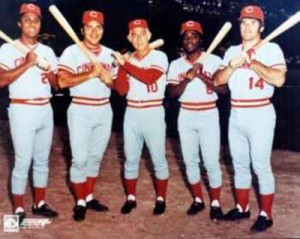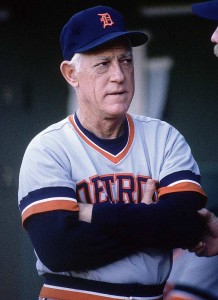Remembering Sparky Anderson: Manager of the Big Red Machine

Sparky ANderson (center) guided the famous Cincinnati "Big Red Machine" to four pennants and two World Series titles in nine seasons.
News this week of the illness and then death of Hall of Fame manager George “Sparky” Anderson has elicited many fond memories of the feisty manager who enjoyed unparalleled success during 26 seasons managing the Cincinnati Reds and Detroit Tigers.
When Anderson was introduced as the new manager of the Cincinnati Reds prior to the 1970 season many asked “Sparky Who?” and wondered why management would turn the reins of one of baseball’s up and coming teams to an unknown 36-year-old who had spent one season playing in the majors for the Philadelphia Phillies (hit .218 in 152 games in 1959) and never managed above AA.
As it turns out, Cincinnati General Manager Bob Howsman, who had hired Anderson for minor league managerial stints with the St. Louis Cardinals and Cincinnati Reds, had the manager he needed to turn the Reds into baseball’s team of the 1970s.
It didn’t take long for Anderson to prove that he was indeed the right man for the job. During his first season at the helm, the Reds won 102 games and reached the World Series for the first time since 1961.
Though they lost the Series to the Baltimore Orioles, with emerging superstars like Johnny Bench, Pete Rose, Tony Perez and Dave Concepcion, the “Big Red Machine” had been born.
After an injury-induced dip in 1971, the Reds returned to prominence in 1972 and again reached the World Series. This time they lost to the Oakland A’s in a dramatic seven game showdown.
Cincinnati won 99 and 98 games respectively over the next two seasons, but lost to the New York Mets in the 1973 playoffs and finished behind the Los Angeles Dodgers in the Western Division in 1974.
By the 1975 season many were wondering if the Reds would ever be able to reach the peak that the talented squad seemed capable of achieving.
Prior to the 1975 season, Anderson made one of the most important strategic decisions of his career when he moved 34-year-old All-Star leftfielder Pete Rose to third base in order to insert 26-year-old slugger George Foster in the outfield on a full-time basis.
The results were immediate as Foster gave the team another powerful offensive weapon with 23 home runs, 78 RBI and a .300 batting average. Rose became an All-Star at third base and hit .317 with 112 runs scored.
Cincinnati piled up 108 victories during the season and reached the World Series for the third time in six seasons under Anderson’s guidance.
In one of the epic World Series of all-time, the Reds and Boston Red Sox exchanged blows for seven games before the Reds finally emerged with a dramatic 4-3 victory in the seventh game to give Anderson his first title and Cincinnati its World Series crown since 1940.
Cincinnati won 102 games in 1976 and then swept their way through the playoffs sweeping the Philadelphia Phillies in the National League Championship Series and the New York Yankees in the World Series.
That would prove to be the high-point for Anderson in Cincinnati. The next two seasons brought 88 and 92 wins respectively as Cincinnati finished behind the Dodgers each season.
Despite posting an 863-586 (.596) record in nine seasons, Anderson was fired by the Reds following the 1978 season.
He wasn’t out of baseball long as the Detroit Tigers scooped up Anderson to manage their emerging team midway through the 1979 season. He went 56-50 over the remainder of that season and then led the Tigers to winning records in each of the next four seasons.

Anderson spent 17 seasons as manager of the Detroit Tigers and led them to the 1984 World Series title.
Playing in a division that included two of baseball’s most powerful teams of the era in the Baltimore Orioles and New York Yankees, as well as the improving Toronto Blue Jays and dangerous Boston Red Sox, Anderson’s Tigers were making annual improvement, but had a hard time reaching the summit.
Finally in 1984, the Tigers broke from the gate fast by winning their first nine games and never looked back. They won 104 games to cruise to the division title by 15 games.
After sweeping the Kansas City Royals in the AL Championship Series, the Tigers needed just five games to dispatch the San Diego Padres and claim the World Series title.
Anderson became the first manager in Major League history to win a World Series title in both leagues.
Detroit continued to post winning records over the next four seasons, but reached the post season only one more time. In 1987 they rallied from three games down with one week left in the season to win the AL East by two games over the Toronto Blue Jays.
They then lost to the Minnesota Twins in what would be the final post season series for Anderson as a manager.
In Anderson’s final seven season in Detroit, the Tigers posted only two winning seasons and began to settle near the bottom of the division standings.
During the labor strike of 1994 and 1995, Anderson was a vocal opponent of the strategy by owners to employ replacement players and he refused to manage the substitutes. Though a settlement kept replacements from ever making it to the field, the break from supporting management was one reason Anderson announced his resignation following the 1995 season.
At the age of 61 he had hoped to continue managing, but when no opportunities arose, Anderson retired as the third winningest manager in Major League history with a record of 2,194-1,834 (.545). He was inducted into the baseball Hall of Fame in 2000.
Though Anderson spent nearly twice as long managing the Detroit Tigers (17 seasons) as he did the Cincinnati Reds (9 seasons), Anderson will always be remembered as the excitable manager of one of the most dominant teams in baseball history. He will also be remembered as a teacher of the game as 11 of his former players went on to serve as managers at the Major League level.
Anderson was 76 years old.
It’s really a great and useful piece of info. I am satisfied that you simply shared this useful information with us. Please stay us up to date like this. Thanks for sharing.
rgfamcmw
After looking into a handful of the blog posts on your blog, I truly appreciate your
way of writing a blog. I book marked it to my bookmark webpage list and will be checking back in the near
future. Take a look at my web site as well and tell me how
you feel.
RIP
Nice and interesting
Hi Kerry! Yes, I have come across comments many articles that highlight the importance of video communication. Makes sense, videos are more engaging. But I wouldn’t say they are an alternative to blogging and social media posting. I personally prefer more of a rounded strategy that includes more than one content format. What strategies do you prefer using?
http://allin1panel.com/blog/purchasing-social-media-marketing/
All Around Asphalt transformed our driveway with exceptional
quality and efficiency! Their team was professional, punctual,
and the results exceeded our expectations. Highly recommend for
any asphalt needs!
AAA Electrical Signs provided exceptional service! Their team
was professional, efficient, and the final product exceeded our expectations.
Highly recommend for anyone needing top-notch electrical
signage solutions!